Every spring and fall, I grow a beautiful bed of komatsuna (Brassica rapa var. perviridis), a type of Japanese mustard green related to turnip and rapini. It’s the fastest growing green in my garden (ready to harvest as baby greens within three weeks, fully mature by five weeks), and its spicy, mustardy leaves can be picked at any stage.
I use them as salad greens while waiting for my lettuce to grow, and as stir-fry greens when my bok choy isn’t quite ready yet. They’re especially good in soup, where the stems become tender and the leaves nicely wilted, but not too soggy the way spinach can get. I love them in Asian soups, such as udon, ramen, or a hearty oxtail soup with radish and carrots. And if you let the leaves grow large, they make a good wrap for fillings as well.
I sometimes forget how fast they grow, so imagine my surprise when — after letting my husband take care of the garden for a week while I caught up on work — I walked outside and saw the komatsuna nearly exploding out of their bed (the other stuff exploding behind the komatsuna is my rhubarb plant — only one, I might add!).

Since there was no way I could eat that many salads, stir-fries and soups all at once, I decided to put them up in one big batch of Vietnamese pickled mustard greens, or cải chua as it’s called.
Cải chua is one of the traditional pickles in Vietnamese culture, the same way đồ chua is. I actually grew up eating more of the pickled mustard because it’s the perfect accompaniment to my family’s many salty home-cooked dishes, like cá kho tộ (braised and caramelized catfish in a clay pot) and thịt ko (braised and caramelized pork belly with hard-boiled egg). These are dishes you typically won’t find on a Vietnamese restaurant menu, but they’re made in every Vietnamese home.
But cải chua is not just a Vietnamese thing. The spicy and sour flavor works well with almost any rich and hearty dish, such as fried fish, grilled sausage, Cajun-style seafood, meatballs and rice, or even a pungent Korean or Chinese noodle soup (I like to saute my cải chua with garlic and ginger before adding it as a topping; it gives the whole soup a tangy-ness and spiciness you won’t get from other ingredients).
Unlike đồ chua, which is pickled in vinegar, cải chua is typically fermented over a period of weeks. As you learned from my ruby kraut recipe, lacto-fermented foods are highly beneficial on their own; then you add in the mustard oils from komatsuna (or any mustard green), and you have quite a nutritional powerhouse. (Learn about mustard oils from my nasturtium pesto post, and about mustard greens in general from World’s Healthiest Foods.)
Vietnamese Pickled Mustard Greens (Cải Chua)
Makes 2 quarts
Ingredients
For the Vegetables
2 1/2 pounds mustard greens
4 stalks of green onions
1 1/2 tablespoons pickling salt
4 Thai bird’s eye chiles (or 2 serrano peppers)
For the Brine (Optional)
2 cups water
1 tablespoon pickling salt
Making Your Vietnamese Pickled Mustard Greens (Cải Chua)
I use komatsuna in this recipe, but you can use any mustard green you have on hand.
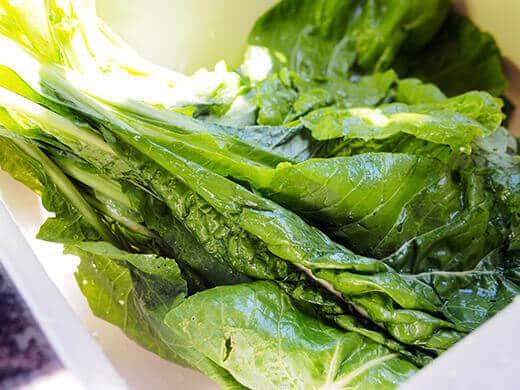
Thoroughly wash, dry, and chop the greens into bite-sized portions. I like to de-stem the komatsuna and cut the stems into 1-inch pieces, then use a chiffonade technique to cut the leaves into long ribbons.

Chop the green onions into 2-inch pieces.
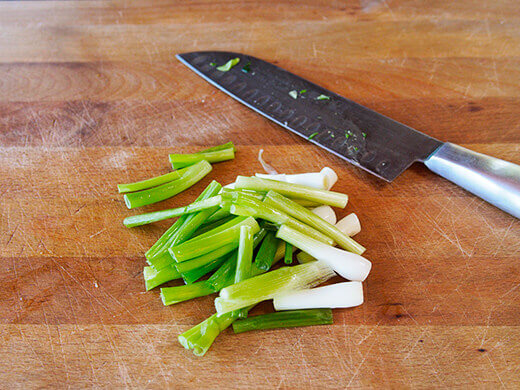
In a very large bowl, combine the greens, onions and salt, and toss to evenly distribute all the salt. Let the vegetables sit for 20 to 30 minutes while the salt draws out moisture.
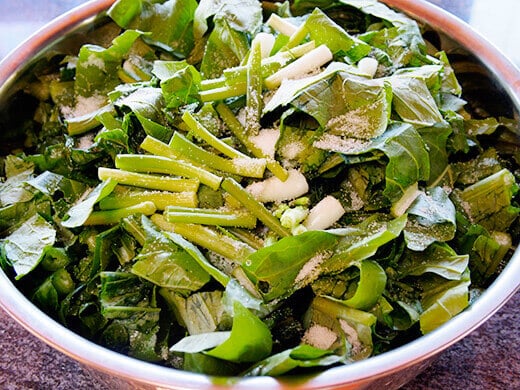
Knead the veggies with your hands until the greens have wilted and the volume is reduced to half. There should be a pool of liquid in the bottom of the bowl.
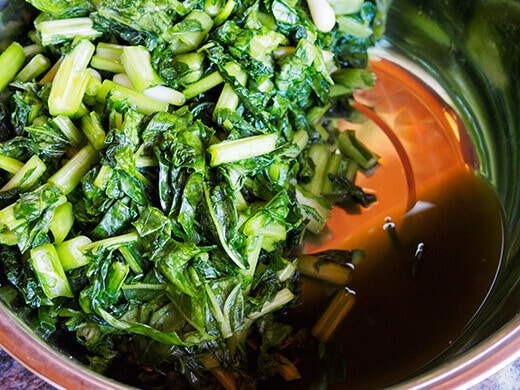
Split the chiles in half lengthwise. Fill the jars about two-thirds of the way with equal amounts of greens and chiles. Tamp down the veggies with the back of a spoon to squeeze out as much liquid as you can.
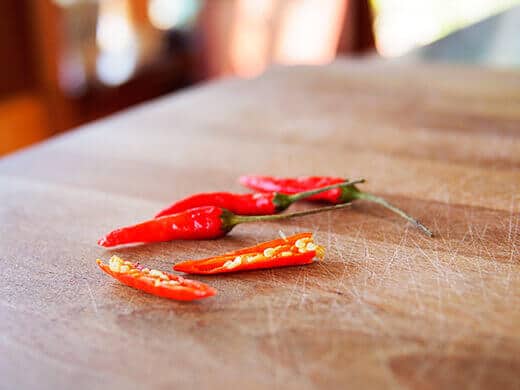

If your veggies are not fully submerged in their own juices, you can top them off with brine. Bring water and salt to a boil, and stir until the salt is dissolved. Let the brine cool, then pour it into your jars until the veggies are barely covered (they will continue to expel liquid as they ferment, so you don’t want to overfill the jars).
Run a chopstick or the end of a long spoon around the jars to release any trapped air pockets. You want to make sure the veggies are completely covered in liquid.
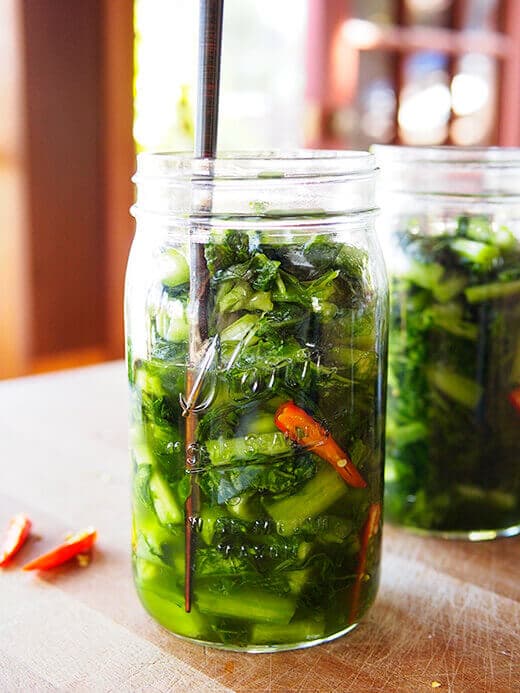
Line the jars with plastic zip-top bags and press down on the veggies. Fill the baggies with a little water (or a rock) to keep them weighted. The baggies should completely contact the surface of the veggies so that no part is exposed to air.
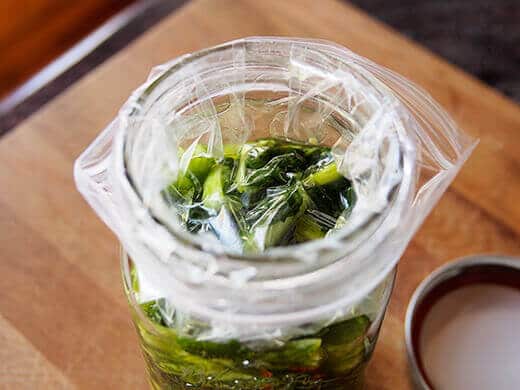
Seal the jars loosely with lids and store them at room temperature out of direct sunlight. Every day or so, check the jars to ensure the veggies are still submerged, pressing down on them with a spoon as needed to release more liquid. As long as the liquid stays above the veggies, you won’t see any mold.
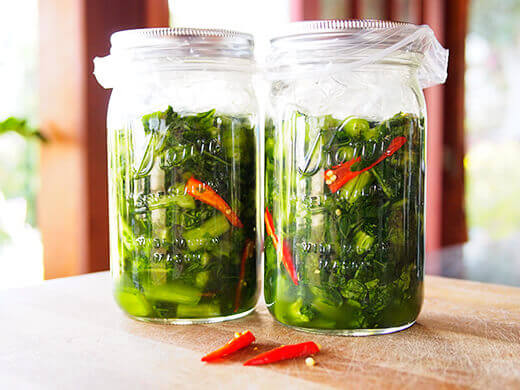
As the greens start to ferment, they’ll turn a lovely shade of olive. Properly fermented mustard greens retain their mustardy bite, but have a pleasantly sour taste and smell like pickles… spicy pickles! If they smell off in any way (yeasty, rotten, or not very pickle-like), chuck them and start over.
You can taste the cải chua after one week to gauge the amount of sourness and spice, but typically it won’t be ready for two to three weeks. The warmer your room is, the faster it’ll ferment.
Once the cải chua has soured to your liking, remove the baggies, reseal with lids, and refrigerate. It will keep for a long, long time — much longer than you’ll need before you finish it all!
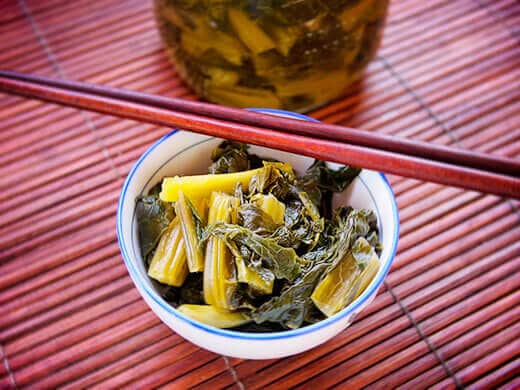
Vietnamese Pickled Mustard Greens (Cải Chua)
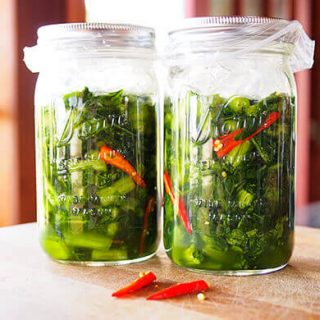
Cải chua is one of the traditional pickles in Vietnamese culture, the same way đồ chua is. I actually grew up eating more of the pickled mustard because it’s the perfect accompaniment to my family’s many salty home-cooked dishes, like cá kho tộ (braised and caramelized catfish in a clay pot) and thịt ko (braised and caramelized pork belly with hard-boiled egg).
Ingredients
For the Vegetables
- 2 1/2 pounds mustard greens
- 4 stalks green onions
- 1 1/2 tablespoons pickling salt
- 4 Thai bird’s eye chiles (or 2 serrano peppers)
For the Brine (Optional)
- 2 cups water
- 1 tablespoon pickling salt
Instructions
- Thoroughly wash, dry, and chop the greens into bite-sized portions.
- Chop the green onions into 2-inch pieces.
- In a very large bowl, combine the greens, onions and salt, and toss to evenly distribute all the salt. Let the vegetables sit for 20 to 30 minutes while the salt draws out moisture.
- Knead the veggies with your hands until the greens have wilted and the volume is reduced to half. There should be a pool of liquid in the bottom of the bowl.
- Split the chiles in half lengthwise.
- Split the chiles in half lengthwise. Fill the jars about two-thirds of the way with equal amounts of greens and chiles.
- Tamp down the veggies with the back of a spoon to squeeze out as much liquid as you can.
- If your veggies are not fully submerged in their own juices, you can top them off with brine.
- Bring water and salt to a boil, and stir until the salt is dissolved. Let the brine cool, then pour it into your jars until the veggies are barely covered (they will continue to expel liquid as they ferment, so you don’t want to overfill the jars).
- Run a chopstick or the end of a long spoon around the jars to release any trapped air pockets. You want to make sure the veggies are completely covered in liquid.
- Line the jars with plastic zip-top bags and press down on the veggies. Fill the baggies with a little water (or a rock) to keep them weighted. The baggies should completely contact the surface of the veggies so that no part is exposed to air.
- Seal the jars loosely with lids and store them at room temperature out of direct sunlight.
- Every day or so, check the jars to ensure the veggies are still submerged, pressing down on them with a spoon as needed to release more liquid. As long as the liquid stays above the veggies, you won’t see any mold.
- You can taste the cải chua after one week to gauge the amount of sourness and spice, but typically it won’t be ready for two to three weeks. The warmer your room is, the faster it’ll ferment.
Notes
I use komatsuna in this recipe, but you can use any mustard green you have on hand.
Recommended Products
As an Amazon Associate and member of other affiliate programs, I earn from qualifying purchases.
-
Ball Mason 32 oz Wide Mouth Jars with Lids and Bands, Set of 12 Jars.
-
Organic Bamboo Cutting Board Set of 3 with Lifetime Replacements - Wood Cutting Board Set with Juice Groove - Wooden Chopping board Set for Kitchen, Meat and Cheese - Wooden Cutting Boards for Kitchen
-
ZWILLING Pro 7-inch Rocking Santoku Knife, 7'', Black/Stainless Steel


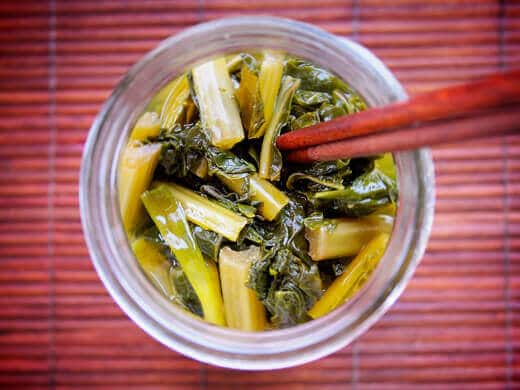
















Hi What is an alternative solution if I don’t want to use plastic or have plastic contact with the food ?Thanks
I’m glad you asked this because my new way of doing it is using a glass weight instead of a plastic baggie. I use these ones, which are food-safe: https://amzn.to/3dK2zjH (for wide-mouth jars) and https://amzn.to/31tgmbV (for regular-mouth jars).
Thanks, i forgot these existed!
I guess I’m going to be growing lots of komatsuna and mustard this year. All gonna get pickled!
I’d also add a tip: make sure everything you use in the prep is conspicuously clean of oil. Ruined many a batch when i got lax.
What a beautiful site you have! Your photography and writing skills are great. And I love the instructions for how to pickle these mustard greens without vinegar. I’ve done it before, but I’m always learning from people like you who take the time to show/teach others. I’m off to see if you have recipes made from these pickled mustard greens (I found you by searching for “cai chua”…was hoping for a soup with pork riblets or a pork braise using the pickled greens. Just any recipe as I love the tartness from the fermentation.
Hi Hang, I’m glad you found my blog! I haven’t posted any recipes using cai chua yet, as I tend to just add it to whatever I’m making at the time. I make a lot of different Chinese noodle soups (heavier and richer than traditional Vietnamese soups) and like to add cai chua on top for some lightness. It’s also delicious on ramen, and on non-Asian dishes as well. I’ve tried it with grilled sausages and on top of fried eggs too.
I just tasted the greens I have fermenting according to your directions-Only I chose garlic over green onion and added julienned pear for just a touch of sweet. They are SO delicious! How will I wait another couple weeks?!
If the taste has already fermented to your liking, feel free to eat as is!
A traditional pickle that’s good for your gut: Vietnamese Pickled Mustard Greens (Cai Chua) http://t.co/rplVfrCrH7 #ferment #canning
The tangy-ness comes from fermentation, not vinegar. Vietnamese Pickled Mustard Greens (Cai Chua) http://t.co/zsSSJqfMPf #preserving #recipe
Eat these with salty dishes of all types, from Asian to Cajun. Vietnamese Pickled Mustard Greens (Cai Chua) http://t.co/2TD2ponHXs #recipe
Lacto-fermented mustard greens are good – in more ways than one! Vietnamese Pickled Mustard Greens (Cai Chua) http://t.co/Yc8d7crdyt #recipe
Thanks for the terrific idea for preserving abundance of greens. Komatsuna is a favorite of mine, tender, large, prolific and stands up well to cabbage worms (some years ;)). I’m definitely going to make a batch this weekend. Oooooh my dill is going to seed and I was just lamenting it going so fast as cuke seeds were just planted and this dill had no use. Looking at your beautiful jars, I thought I saw dill sprigs included. I know they weren’t, but wouldn’t that be interesting? To add dill head to kimchi or these komatsuna pickles? Mebbe yes, mebbe no, Mr. Danger! Thanks again Linda for an inspired post!!!
I do dill seed in my ruby kraut, so I think fresh dill would be just as delicious!
The recipe looks intriguing but what I’m most impressed with is your ziplock baggie/jar lid fermenting technique. Genius!
Esther Van de Klundert liked this on Facebook.
Delicious as a side with salty meats, or as a topping on soup. Vietnamese Pickled Mustard Greens (Cai Chua) http://t.co/KbsUfHqKxA #recipe
Thanks for sharing this recipe. The past two years I’ve tried kraut ferments (after I got too much cabbage from my CSA share). Now, I’ve got a lot of bok choy, but was intimidated by how the mustard-y flavor and leaves would ferment. Jumped right in and got a crazy ferment going: ginger, bok choy with seed pods & florets, arugula buds, purple cabbage and garlic scapes. It’s just staring to get its wang and think it’s going to be tasty! Off to check out your pickled kohlrabi as that’s what’ll be up next for harvest.
Your ferment-a-thon sounds amazing! My garlic scapes are just starting to appear now and those would be great in a kraut!
Agree wholeheartedly, garlic scapes in ferment juju is inspired! Have a whole bag in the fridge and I think some will go into my next kimchi batch.
Now that you’ve learned to ferment your own kraut, try this: Vietnamese Pickled Mustard Greens (Cai Chua) http://t.co/VVEKsQtNsc #recipe
Maureen Hope Wall liked this on Facebook.
Hello Betty
I have no idea whether the comment that I wrote just now was delivered or not (I am not good at the techi bit), but if it wasn’t I would like to say, as a London Grandma living on a Spanish orange grove, that yours is the only blog that I follow and it seems that I have been following your delightful blog since pretty well the beginning. My husband and I love your recipes and your chat. We visited China and Japan many years ago and really enjoy Asian food, my husband is also a chilli head and now grows his own in many varieties. We have more food than we can possibly eat and make jam, pickles and preserves, we also dry stuff, figs stuffed with walnuts, tomatoes sprinkled with sea salt and basil – the sun is hot and wonderful. Your blog is an inspiration. Happy birthday for last week, you are appreciated. Sarah and Adrian xx
Thank you for the very kind comment! I am constantly amazed by the diversity of people who read my blog and it’s such a treat to know I’m reaching someone from across the Atlantic! It sounds like you live in the perfect climate for all that you do and grow; I cannot wait for my figs and tomatoes to start ripening in abundance!
Just a note for readers–if you use salt in a fermentation recipe, use sea salt or kosher, NOT iodized.
Yes, very good reminder! Canning/pickling, kosher or sea salt only.
I think pickling salt is best because it’s chemically pure. Kosher salt has anti-caking agents, and sea salt might have naturally occurring iodine (which will halt or slow fermentation)
Not all brands of kosher salt contain anti-caking agents. Best to check the label!
looks yummy!
Tracy Adams Doiron liked this on Facebook.
Kelly Ruff liked this on Facebook.
RT @BG_garden: Vietnamese Pickled Mustard Greens (Cải Chua):
Every spring and fall, I grow a beautiful bed of komatsuna (Bra… http://t.c…
Vietnamese Pickled Mustard Greens (Cải Chua):
Every spring and fall, I grow a beautiful bed of komatsuna (Bra… http://t.co/ChIvZsjZAv
Blogged on Garden Betty: Vietnamese Pickled Mustard Greens (Cải Chua) http://t.co/ASXHCxjw6g